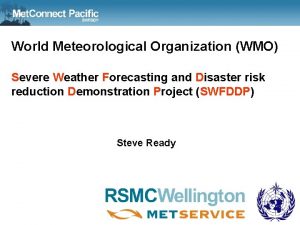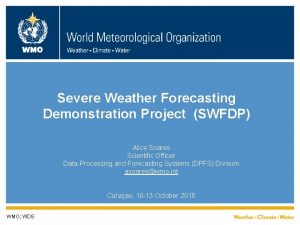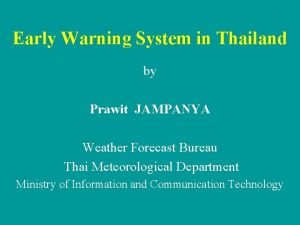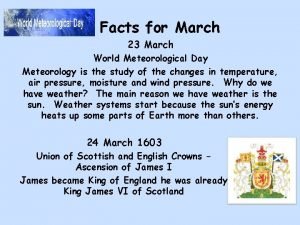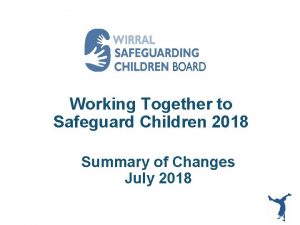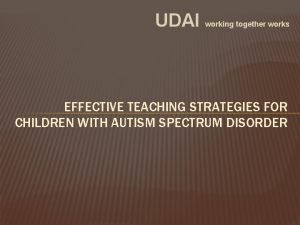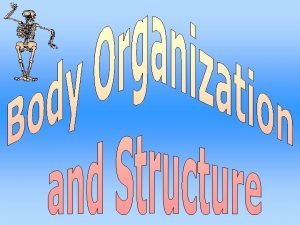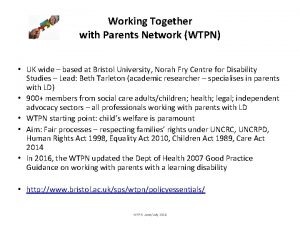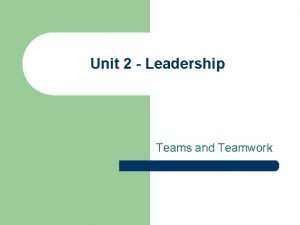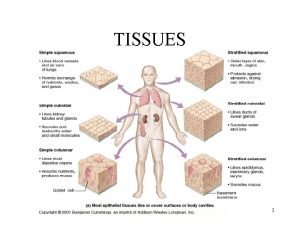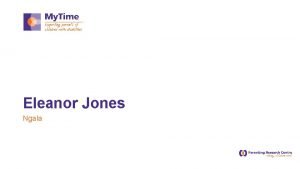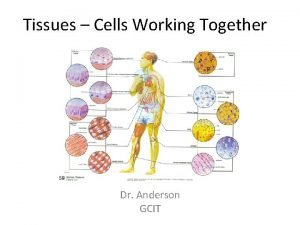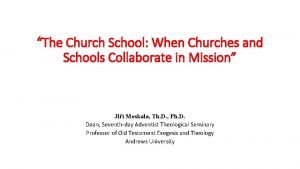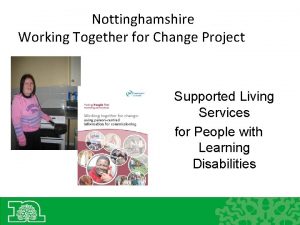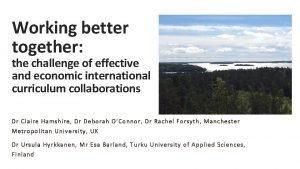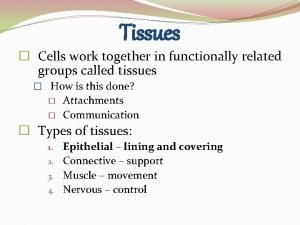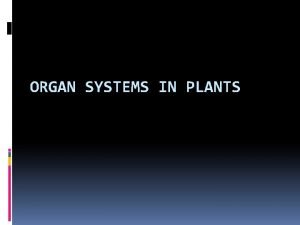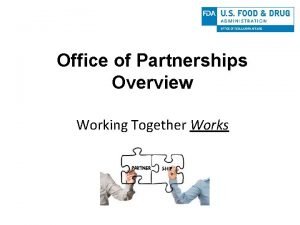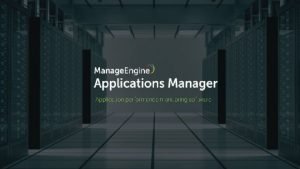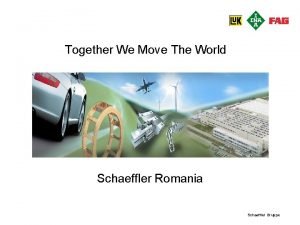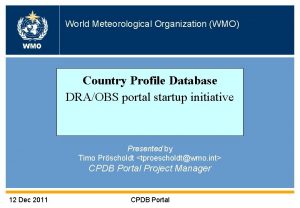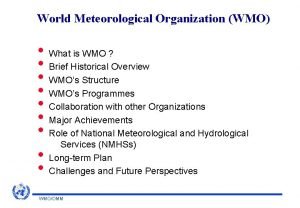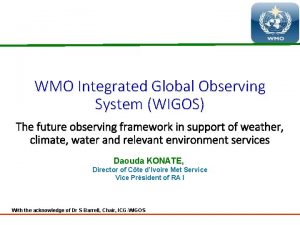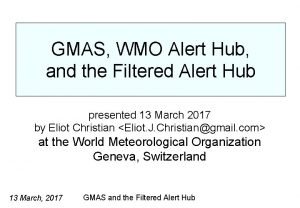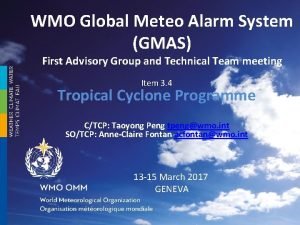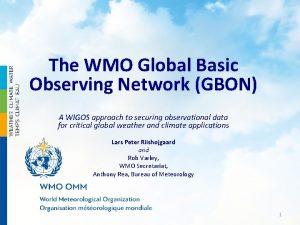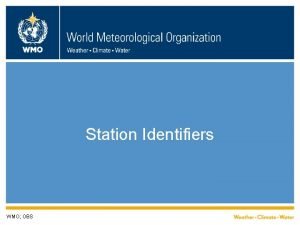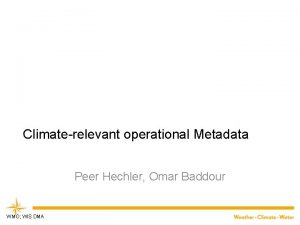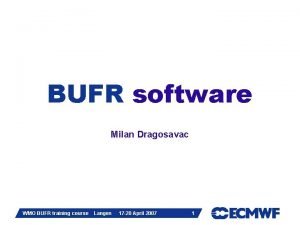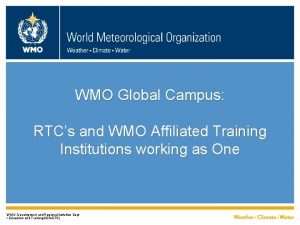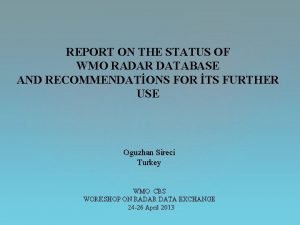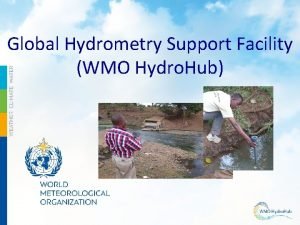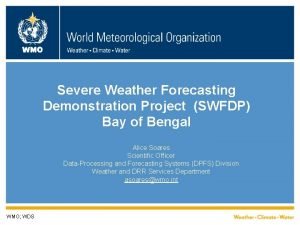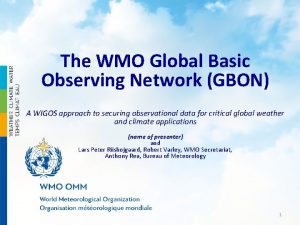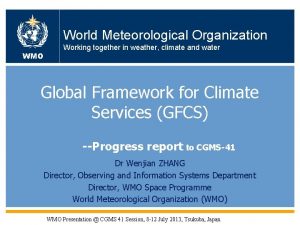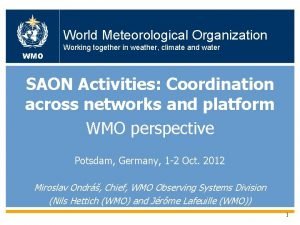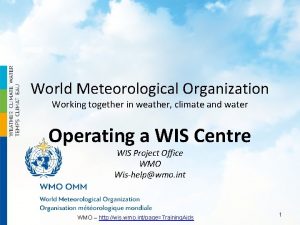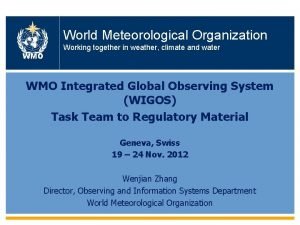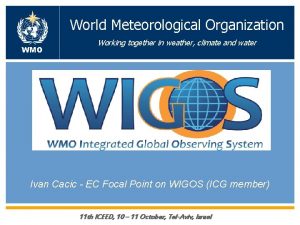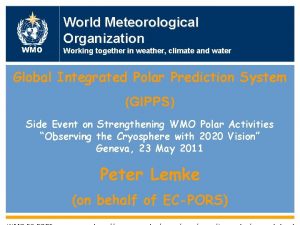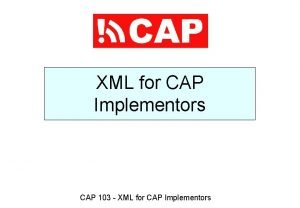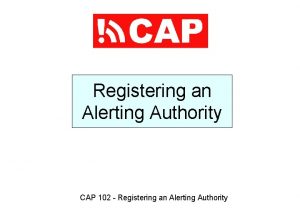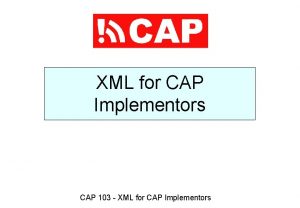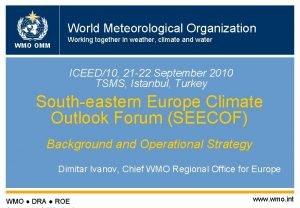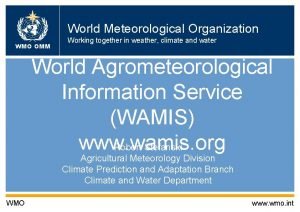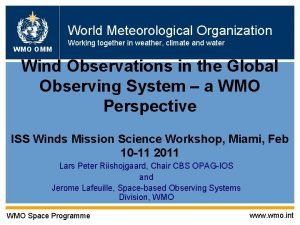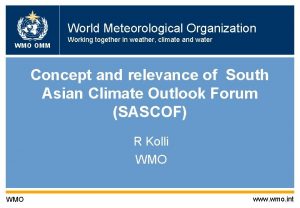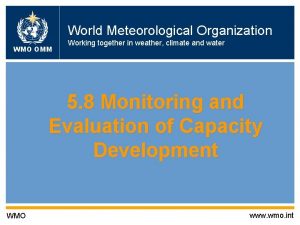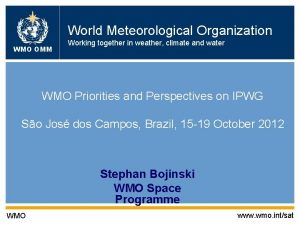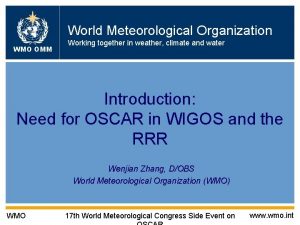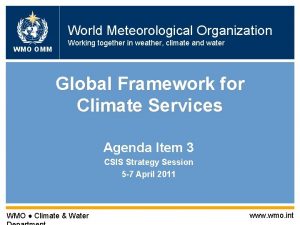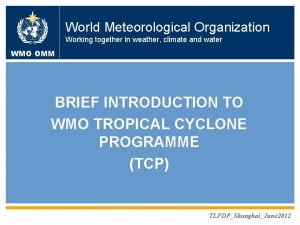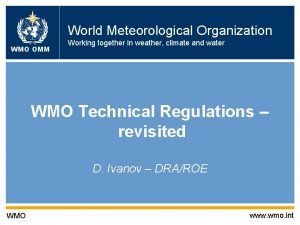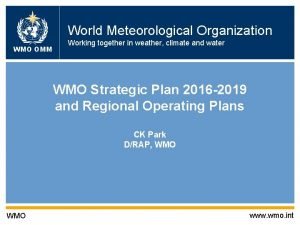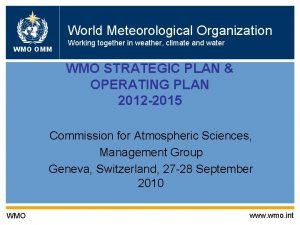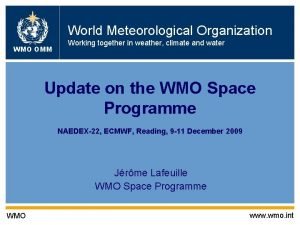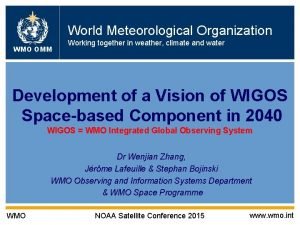World Meteorological Organization WMO Working together in weather

































































- Slides: 65

World Meteorological Organization WMO Working together in weather, climate and water WIGOS – WMO Foundation for Meeting the Observing needs of Weather, Climate, Water and Environment Services --Congratulations to the RA IV WIGOS Workshop --Welcome to all participants and thanks to our local host !! Dr Wenjian Zhang Observing and Information System Department, WMO www. wmo. int/pages/prog/www/wigos/

2

4. 4. 10 The Association accordingly adopted Resolution 1 (RA IV-16) – Regional WMO Integrated Global Observing System WMO OMM Implementation Plan. • The Association agreed that the implementation of R -WIP-IV be supported by all the Members of the Region, and be guided, supervised and monitored by the Management Group of RA IV, with periodic reports from appropriate subsidiary bodies in charge of WIGOS. • The Association further agreed that R-WIP-IV be further revised to accommodate new projects which would be submitted by Members and authorized the president to approve the revised R-WIP-IV during the intersessional period in consultation with the Management Group. In this regard, the Association 3 agreed that the regional WIGOS projects should be

World Meteorological Organization WMO Working together in weather, climate and water --Secretariat role and support in the WIGOS Pre-Operational Phase Dr Wenjian Zhang Observing and Information System Department, WMO www. wmo. int/pages/prog/www/wigos/

WMO OMM WIGOS: Integral part of NMHS and key enabler of their value proposition WIGOS + National societal needs

WIGOS Pre-operational Phase WIGOS framework Polar Regulatory & Guidance Material GFCS Data quality monitoring system DRR Information Resource (WIR) Regional WIGOS Centres National WIGOS implementation WIGOS Pre-operational Phase: unique chance ! WMO OMM WMO priorities Aviation

WMO OMM Implementing WIGOS is critical for Members to serve their nations! WMO INTEGRATED GLOBAL OBSERVING SYSTEM The whole is more than the sum of the parts—Aristotle WIGOS- needs to meet weather, climate, water and related environmental services requirements WMO: Dr Zhang

WMO OMM WIGOS Vision Requires… § Addressing, in a cost-effective and à Align with WMO priorities and sustained manner, the evolving national mandates observing requirements of Members such as DRR, GFCS in delivering their weather, climate, and service water and related environmental outcomes services; à Cultivate & support a § Coordinated, comprehensive, culture of reliable & trusted observations for compliance WMO and co-sponsors; § Enhanced coordination & cooperation at regional, subà Coordinate & build regional and national levels for the alliances for benefit of society. interoperable

WMO OMM 1. WIGOS Regulatory Material complemented with necessary guidance material to assist Members with the National WIGOS implementation

WMO OMM 1. WIGOS Regulatory Material development plan during Pre-operational phase- role of the Secretariat • Develop four-year roadmap (workshops/meetings) supporting the coleading technical commissions (CBS & CIMO) for developing Phase II Reg Material (AWS, Radar, Wind Profilers, New Gen Met. Sats, …) • WIGOS are both “Integration & Evolution”, need to move essential part of EGOS-IP into WIGOS Manual • Coordinating Relevant TCs and Steering

2. Further development of the WIGOS Information Resource (WIR), with special emphasis on the operational deployment of the OSCAR databases

WMO OMM 2. Further development of the WIGOS Information Resource (WIR), - four year plan • Within next 2 years the great collaboration between Meteo. Swiss & WMO on OSCAR surface will start operational; • The role of Secretariat with take care of Members’ registration & update during the Op phase • Secretariat will also

WMO OMM 3. Development and implementation of the WIGOS Data Quality Monitoring System

WMO OMM Current monitoring the Average availability of SYNOP, TEMP and CLIMAT data at MTN centres AGM: example Period 1 -15 October (2011 / 2012) Surface (SYNOP) Upper-air (TEMP) CLIMAT Number of stations / Reports received (%) WMO Region RA III RA IV RA VI Antarctic Global 2011 2012 782 (56%) 781 (57%) 84 (29%) 81 (26%) 737 (33%) 723 (37%) 1366 (92%) 1367 (92%) 274 (83%) 274 (75%) 666 (88%) 666 (85%) 436 (70%) 435 (68%) 53 (54%) 53 (53%) 309 (90%) 298 (82%) 534 (89%) 531 (85%) 133 (96%) 132 (93%) 317 (90%) 317 (88%) 400 (79%) 399 (74%) 92 (71%) 89 (66%) 251 (81%) 248 (81%) 831 (97%) 840 (97%) 127 (78%) 125 (78%) 585 (96%) 586 (91%) 105 (77%) 15 (53%) 15 (56%) 105 (44%) 105 (67%) 4454 (83%) 4458 (82%) 778 (75%) 769 (71%) 2970 (74%) 2943 (74%)

WMO OMM Current Monitoring Status and Major shortcomings • Only use two weeks of statistics of the whole year • Only for registered RBSN/RBCN in Volume A, no other components of WIGOS • Only at Six Regions and Antarctic (no details) • Only taking care of data availability (no quality monitoring function) • Only communicate the outcome of data

WIGOS Monitoring System Development plan (Pre-Op Phase) Will use who year statistics of the data availability WMO OMM • • Will start with registered RBSNs/RBCNs, but will steadily inclusion of other components of WIGOS • Will detail at National level for data availability (target at EC 2017, with much details) • Will monitoring data quality based upon major NWP outcomes • Will communicate the outcome of data availability & data quality at least monthly and accumulating (Web info NRT) • Role of secretariat: organizing workshop & co-

WMO OMM Progress so far 1. Meeting TT-WQM-1 at WMO, 17 -20 June 2014: – Update of Terms of Reference, – Concept of the WIGOS Workshop on Observational Data Monitoring, – Future Work Programme and Action Plan 2. A WQM workshop Nov. 2014 decided to initiate a GOS QM Pilots (SG-QM) – Pilot (2015 - ECMWF, NCEP, others) [R. Grumbine, D. Richardson] – Participating NWP centers to agree on: • Information to exchange; • Format for exchange; • Feasiblity and commencement. 3. Second workshop is schedules at Dec. 17 -18 in Geneva

WMO OMM WDQMS 2 b – Existing GOS Monitoring • Monthly Monitoring Centres: – ECMWF; RSMC Exeter; WMC Melbourne; RSMC Montreal; RSMC Offenbach; RSMC Tokyo & RSMC Toulouse • Lead Centre Monitoring: – WMC Washington (aircraft and satellite); ECMWF (upper air); RSMC Exeter (surface marine); RSMC Nairobi (RAI); RSMC Tokyo (RAII); RSMC Buenos Aires (RAIII); RSMC Montreal (RAIV); WMO Melbourne (RAV) & RSMC Offenbach (RAVI) • Regular reports produced by many Monitoring Centres but follow up actions are variable • A number of effective monitoring functions are in place for other observational programmes, for example the CBS Lead Centres for GCOS monitoring; GAW monitoring etc • Important to learn from the experiences of these groups

WMO OMM WDQMS 2 d – expected results • WDQMS will allow Members to: – rapidly detect problems with the observational data being exchanged (or not being exchanged) – quickly identify actions that can solve any issues highlighted (more than monitoring) • This in turn will lead to increased availability and improved quality of observational data being made available to users

WMO OMM Deliverables Long term: (-2020) • The WIGOS Quality Monitoring System (WQMS) established with: § WMO Lead Centres, Monitoring Centres and Regional Centres § A fault management system/ reporting system for QM Short to medium term: (-2017/18) • A quality monitoring and fault management system in connection with ECMWF and perhaps other global NWP centres for GOS starting from selected pilots. 20

4. Concept development and initial establishment of Regional WIGOS Centres (facilities)

WMO OMM Major Role of the Regional WIGOS Centres (RWC) • The overall purpose of the RWCs is to provide support and assistance to Members and Regions for their national and regional WIGOS implementation. • During the Pre-Operational Phase, the RWCs will provide a link between the WIGOS Project Office in the WMO Secretariat and the individual WMO Members, and it will be able to support the implementation efforts of the Members far more effectively and efficiently that it could be done centrally from the Secretariat.

WMO OMM Regional WIGOS Centers & WQM practices Feedback loops are recommended between: • Observational data quality monitoring systems and data providers: § (Near) real time, § identify problems and take corrective actions, § provide guidance material (“lessons learned”) • Observational data providers and the user community: § In case, user expectations are not met, § Make solutions available from members for members § ICG-WIGOS should consider a recommendation 23

WMO OMM ST-QM – 04. 02. 2015 24

WMO OMM responsibilities of the RWCs • The views expressed during ICGWIGOS-4 (Final Report, ICG-WIGOS-4, Annex II to para 9. 2) were that: – A basic function of RWC must be regional coordination and support of WIGOS implementation and operational activities at regional/national level. (day-to-day level of activities)

WMO OMM MANDATORY functionalities – full functional centers • Work with data providers to facilitate WIGOS data and metadata collection, transmission & update (implementation and input to OSCAR/Surface) • Regional performance monitoring of WIGOS networks (data availability, timeliness, quality) • Feedback to data providers, i. e. follow-up with data providers in case of data availability or data quality problems.

WMO OMM OPTIONAL functionalities could include: • Assistance in the coordination of regional/sub-regional WIGOS projects • Advice to Members on the requirements for the regional network design. • All areas of support listed above are expected to be covered in all WMO Regions. However, this may be accomplished via several RWCs with complementary areas of expertise rather than through a single RWC

WMO OMM PO The RWCs will also work closely with their respective WMO Regional Office and other Regional centers to ensure efficient and effective implementation of WIGOS RA MG WMO RO technical support, CD governance RWC Member/s liaison RIC RCC RTC WIS etc

Progress & Issues for support & guidance Technical support to regional WIGOS projects (virtual home of RA VI WIGOS WG) Supporting regional Members wrt technical solutions on WQM WMO OMM Input to WIGOS OSCAR WIGOS Centers (RA WIGOS Teco Arm) Monitoring regional data quality & availability (with inf

Global 5. National WIGOS Implementation Regional National

Approach to National WIGOS Implementation WMO OMM • For the WIGOS Implementation, All countries are different • Each NMHS shall Set goals & objectives for WIGOS according to national needs – Critical analysis of capabilities and gaps of current services vs national social economic development, with a Vision for 2025 – Clear view on the reliance on national WIGOS, observing gaps and overall plan and roadmap – Focus plan on priority areas, with achievable projects and phases • Establish governance within NMHSs and Coordination mechanism with key partners & key test footer 31

WMO OMM The role WMO Secretariat Support to Members – my views Members may face both challenges for implementing WIGOS which needs WMO Secretariat Support: • Political/governance & administration support – National WIGOS Coordination Mechanism – enpower NMHSs – Data Policies, share and exchange information and data in NRT – Convincing national budget authorities for resources • Role of Secretariat: – SG and high level officers should approach responsible national ministers, at the request of PR or attending high level events, to convince nations to execute UN resolutions – Secretariat will further enhance communications on the social test footer 32

WMO OMM

WMO OMM

WMO OMM

WMO OMM The key for success- strengthen governance 36

Organizational WIGOS Governance/working Structure WMO OMM CONGRESS Executive Council 6 Regional Associations 8 Technical Commissions Inter-Commission Group -WIGOS RA WGs/TT on WIGOS ICG Task Teams Technical Commission Inter-Program ETs Secretary-General WMO/OMM Secretariat oversight board

Technical aspect of National WIGOS Implementation WMO OMM Example: WDQMS – Context • Throughout the new WIGOS Regulatory Material there are references to the observational data quality expectations placed on members: Technical Regulations Vol. 1 2. 4. 3 Performance 2. 4. 3. 1 Members shall continuously monitor the performance of their observing systems. 2. 4. 4 Quality Control 2. 4. 4. 1 Members shall implement quality control for all observations for which they are responsible. Manual on WIGOS 2. 4. 3 Quality Control 2. 4. 3. 1 Members shall ensure observations provided through their WIGOS component observing systems are quality controlled. 2. 4. 3. 2 Members shall implement real-time quality control prior to exchange of observations via the WMO Information System.

Communicating WIGOS Benefits are critical for Successful WIGOS Implementation !

Global Societal Needs ! The global total economic losses by decade and by hazard type in USD billions WMO OMM adjusted to 2011 • The warmer planet, leading to • • more frequent extreme Weather & Climate events Global population above 9 billion in 2050, with growing in 2050, with settlements in costal regions & megacities (50% 72%) 780 million have no access to clean water 7 million premature death due to air pollution Increase of vunerability & greater loses !!! WMO: Dr Zhang 40

WMO OMM The plenat will be warmer, leading to more frequent extreme events in 2040 NMHSs will morph from the weather business into an environmental intelligence enterprise 41

WMO OMM Outlook of future in 2040: challenges of WMO Members for meeting anticipation Services Requirements in 2040 ØThe sea level will continue rising, lead to the coastal regions in more risky areas ØAverage tropical cyclone intensity (maximum wind speed & rainfall) is likely to increase ØThe frequency of heavy precipitation or the proportion of total rainfall from heavy falls will increase in the 21 st WMO: Dr Zhang 42

WMO OMM The sea level will continue rising, lead to the coastal regions in a risky area 43

CGMS-43, Boulder, CO, May 2015 44

Storm Surge wave heights higher than 20 feet ! 45

Great losses: 1000 death toll and >100 Billion $ 46

How the space observations can help the Hurricane intensity forecasting ? 47 • (a) Intensification is not correlated with sea surface temperature (from POES highresolution infrared data), (b) In contrast, the intensifications correlate well with highs in the ocean dynamic topography (from Jason 1, TOPEX, Envisat, and GFO sea surface height data). CGMS-43, Boulder, CO, May 2015

How the space observations can help the Hurricane intensity forecasting ? • • • 48 It’s well known that tropical cyclones require warm water to form. Sea surface temperatures (SSTs) must be above 26°C throughout a depth of about 46 metres. Since SSTs can change rapidly due to mixing processes and correspond to only about the top 10 metres, SST by itself does not provide sufficient information about the heat content stored in the upper ocean to accurately forecast tropical cyclone intensity. We get far more reliable data from altimeters, since sea surface height anomalies are strongly correlated with the internal thermal structure of the ocean.

WMO OMM Global risk along the costal Megacities !! 49

World Meteorological Organization WMO OMM Working together in weather, climate and water Conclusion: Sustain the Altimetry & Ocean Observation Mission ! WMO www. wmo. int 50

Regional Distribution of Number of Disasters, Casualties and Economic losses Caused by natural WMO OMM hazards (1980 -2007) Number of events Loss of life Economic Losses Source: EM-DAT: The OFDA/CRED International Disaster Database - Université Catholique de Louvain - Brussels - Belgiumc

WMO OMM Taking full benefit from WIGOS ! By full spectrum of utilizing observations Understanding Analysis WIGOS Monitoring Validation Consequences Assimilation Models Initialization Predictions To demo the WIGOS Benefits from different utilization

Transition to the new generation of GEO SATs WMO OMM • Most geostationary systems start a new generation in the next 5 years: Himawari-8 (Oct. 2014), FY-4 A, GOES-R, GEOKOMPSAT-2 A , MTG-I 1, Electro-M 1 • Guideline for Ensuring User Readiness for New Generation Satellites adopted by CBS-15 : – NMHSs should set up preparation projects – Satellite operators to provide technical information and tools – SATURN portal provides a single access to this information • For RA III: GOES (East) is essential • Considerable improvement with GOES-R • Transition requires special attention See the poster

WMO OMM The role WMO Secretariat Support to Members – my views Members may face both challenges for implementing WIGOS which needs WMO Secretariat Support: • Operational/technical support – Implementation of WIGOS Regulatory Material (Technical regulations, WIGOS Manual, Guides, etc) – Implementation of WIGOS Metadata standards, station identifiers, etc – Support Partners for Implementing WMO RM ((culture of compliance ) – Benefit from/respond to WIGOS Data availability and quality monitoring • Role of Secretariat – Facilitating Technical Commission Experts support test footer 54

WPP Priority Areas – inter-dependent WMO OMM National WIGOS Implementation Regional WIGOS Centers WIR WDQMS WIGOS Manual & Guide

The role of secretariat @ WIGOS WMO OMM Obs information& partners Assist Developing technical docs STd Fostering collaborations among Members 56 Communicate progress and sharing best practice WMO Centers Awareness & training Users

WMO OMM Working together with national/regional Partners The Win-win strategy ! Proverb: If you want go fast, go alone If you want go far, go together 2/25/2021 57

World Meteorological Organization 7 bis, avenue de la Paix CH-1211 Geneva 2 Switzerland k n a h T u o y

WMO OMM Key documents needed at RAs

PROVISIONAL PROGRAMME OF SESSIONS OF CONSTITUENT BODIES DURING THE WMO OMM SEVENTEENTH FINANCIAL PERIOD (2016– 2019) : • EC-68 (June) 2016 – Key documents on WIGOS should be discussed and agreed at ICG 5 (last week of January 2016 after PRA/PTC), then input to EC documents • (Asia) (RA II-16) (Sept) – Key WIGOS documents be communicated (Pre-OP IP, WIGOS Regional Facility-connection to GSICS, etc), and regional WIGOS docs be approved. – OSCAR will be on-site registeration/update at RA II – RBON (or GBON-RA II) concept be communicated and exercised • (CBS-16) (November) – New Regulatory Material be discussed and approved (GOS part) and endorsed – New WIGOS working structure within CBS and collaboration meschanisms 60

WMO OMM PROVISIONAL PROGRAMME OF SESSIONS OF CONSTITUENT BODIES DURING THE SEVENTEENTH FINANCIAL PERIOD (2016– 2019) -- 2017 • (RA IV-17) (North & Central America & the Caribbean)-April – Similar to RA II • EC-69 – Potential update of WIGOS Pre-Op IP, and review of progress – Demo the WIGOS Monitoring development • (CAS-17) – WIGOS Pre-op IP; RBON, Guiding material expected from CAS – On-site registeration check/update on GAW stations • (RA VI-17) (Europe) –Sept. – Global WIGOS documents and Regional documents (ref. RA II) • (JCOMM-5) – OSCAR-GOS Ocean sub-systems and GOOS system registeration • (RA V-17) (South-West Pacific)-Dec. – Global WIGOS documents and Regional documents (ref. RA II) 61

WMO OMM PROVISIONAL PROGRAMME OF SESSIONS OF CONSTITUENT BODIES DURING THE SEVENTEENTH FINANCIAL PERIOD (2016– 2019) - 2018 • (CCl-17) , (CAg. M-17) & (CAe. M-16) – WIGOS key documents and progress review, contributing to the CCl, CAe. M and CAg. M communities • (CIMO-17) – Documents on CIMO leading role of WIGOS, new working structure on WIGOS • (RA I-17) (Africa) & (RA III-17) (South America) • Review of Global & Regional WIGOS progress, communication and decisions. OSCAR on-site registrations/updates • (IBCS-3) – Documents on WIGOS Progress (global and regional) articulate the WIGOS be the GFCS OBS Pillar with all relevant bodies (GCOS, GOOS, etc) • EC- 70 – Overview of Progress of WIGOS at Global, Regional and National levels, demo WIGOS benefits – Preliminary Decisions on WIGOS Operational Phase at Cg-18 (potential of WMO 62 Infrastructure (WIGOS/WIS), Programme suggestion – cross-cutting Programme)

WMO OMM Understanding WIGOS Plans Ø WIGOS Framework Implementation Plan (WIP) : § Plan to develop practices & procedures to be documented in WIGOS Regulatory Material (such as Technical Regulations) § Provides guidance to Regions & Members to prepare their IPs Ø Regional Implementation Plan(s) (R-WIP): § Responding to WIP § Includes Regional priorities § Provides further guidance to Members Ø National Implementation Plan(s) (N-WIP): § Respond to WIP & R-WIP § Includes national priorities § Plan to implement improved functionalities of the existing observing systems based on practices described in the WMO Regulatory Material Ø Agents for implementation: § WIP = TCs (in collaboration with RAs and Members) § R-WIP = RAs (in collaboration with TCs and Members) § N-WIP = Members (in collaboration with RAs and TCs)

WMO OMM Regulatory material & QM practices Feedback loops are recommended between: • Observational data quality monitoring systems and data providers: § (Near) real time, § identify problems and take corrective actions, § provide guidance material (“lessons learned”) • Observational data providers and the user community: § In case, user expectations are not met, § Make solutions available from members for members § ICG-WIGOS should consider a recommendation about adding functionality for this area to the WIR. 64

WMO OMM Costs – Benefits of meteorological investments – CBS TECO 2012 • An estimate in China: a benefit-cost ratio between 35 and 40 (G. Zhang and Wang 2003). • Mozambique Met Service: estimated to have a benefit-cost ratio of 70 (World Bank 2008). • Some European and Asian countries: The ratio of the economic benefits vs costs of met-services modernization programs vary between 2. 1 to 14. 4 for (World Bank 2008). • U. S. National Weather Service benefits vs modernization more than threefold (Lazo, Teisberg, and Weiher 2007). • A Canadian study: gross value of weather forecasting and services to be approximately $1. 2 billion/year (Ekos 2007).
 Wmo severe weather
Wmo severe weather Wmo severe weather
Wmo severe weather Where do polar and tropical air masses develop
Where do polar and tropical air masses develop Thai meteorological department weather chart
Thai meteorological department weather chart March 23 world meteorological day
March 23 world meteorological day Working smart vs working hard
Working smart vs working hard Hot working
Hot working Hot working and cold working difference
Hot working and cold working difference Differentiate between hot working and cold working
Differentiate between hot working and cold working Proses pengerjaan panas
Proses pengerjaan panas Working together to safeguard children summary
Working together to safeguard children summary Teamwork animals working together
Teamwork animals working together Udai working together works
Udai working together works Poem about team
Poem about team A group of similar cells working together.
A group of similar cells working together. Tissues are groups of similar cells working together to
Tissues are groups of similar cells working together to Working together toward a common goal
Working together toward a common goal Root hair cells
Root hair cells Working together with parents network
Working together with parents network Unit 2 teams working together
Unit 2 teams working together Benne and sheats group roles
Benne and sheats group roles Tissues are groups of similar cells working together to
Tissues are groups of similar cells working together to Teachers and teacher aides working together
Teachers and teacher aides working together Teachers and teacher aides working together
Teachers and teacher aides working together Working together agreement
Working together agreement Working better together
Working better together Paraprofessionals and teachers working together
Paraprofessionals and teachers working together Words of wisdom about working together
Words of wisdom about working together Tissues working together
Tissues working together Churches and schools working together
Churches and schools working together Teachers and teacher aides working together
Teachers and teacher aides working together Working together for change
Working together for change Volunteers working together
Volunteers working together Working better together
Working better together Group of cells working together
Group of cells working together A group of cells similar in structure and function
A group of cells similar in structure and function What is a group of organs working together
What is a group of organs working together Working together works
Working together works Opvoedbelasting
Opvoedbelasting Apdex
Apdex Organizational method in speech
Organizational method in speech Weather station model examples
Weather station model examples Autumn tongue twisters
Autumn tongue twisters Poem of seasons
Poem of seasons It's windy weather it's stormy weather
It's windy weather it's stormy weather Whether the weather is fine or whether the weather is not
Whether the weather is fine or whether the weather is not Heavy weather by weather report
Heavy weather by weather report Capital weather gang weather wall
Capital weather gang weather wall Process organization in computer organization
Process organization in computer organization Compare and contrast organization
Compare and contrast organization Together we move the world
Together we move the world Wmo cpdb
Wmo cpdb Wmo country profile database
Wmo country profile database Wigos system
Wigos system Gmas wmo
Gmas wmo Wmo gmas
Wmo gmas Wmo gbon
Wmo gbon Wmo station identifiers
Wmo station identifiers Omar baddour wmo
Omar baddour wmo Wmo bufr
Wmo bufr Wmo regional training centres
Wmo regional training centres Wmo
Wmo Wmo radar database
Wmo radar database Wmo hub
Wmo hub Wmo gdpfs
Wmo gdpfs Gbon wmo
Gbon wmo
